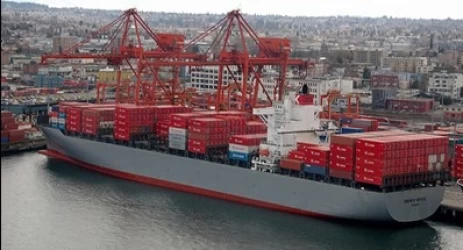Sea transportation of home appliances and furniture from Iran to Canada
Shipping household goods and personal belongings internationally can be a complex and detailed process, particularly when transporting them from a country like Iran to Canada. Whether you're relocating for work, study, or personal reasons, understanding the steps involved in sea freight, including costs, timelines, customs, and logistics, is crucial to ensuring a smooth transition. This guide will provide a thorough overview of the entire process of shipping household goods from Iran to Canada by sea.
1. Overview of Sea Freight Shipping
Sea freight is one of the most common methods for transporting large quantities of goods internationally. For those moving from Iran to Canada, sea freight is an economical option compared to air freight, especially for large shipments such as household furniture, appliances, and personal belongings.
The sea freight process typically involves several key steps:
- Packing and preparation of goods
- Transport to the port of departure
- Customs clearance in Iran
- Shipping by sea to Canada
- Customs clearance in Canada
- Final delivery to your new residence
2. Choosing the Right Shipping Container
When shipping household goods via sea freight, choosing the right shipping container is essential. There are two main types of containers used for sea shipping:
- Full Container Load (FCL): This option involves renting an entire container. It's ideal for large households with a significant amount of goods. FCL provides more security as your belongings won't be mixed with other shipments.
- Less than Container Load (LCL): If you have fewer items, LCL allows you to share a container with other shipments. It’s more affordable for smaller loads but can take longer to arrive since the container will be consolidated with other goods before shipment.
3. Cost Factors in Sea Freight from Iran to Canada
Several factors determine the cost of shipping goods via sea freight from Iran to Canada. Understanding these costs can help you better plan your relocation budget:
- Size and weight of your shipment: Larger and heavier shipments cost more to ship.
- Type of container: FCL is generally more expensive than LCL because you’re paying for the entire container.
- Port of departure and arrival: The distance between the port in Iran and the port in Canada (most commonly Vancouver, Montreal, or Halifax) will affect the cost. Shipping to ports farther inland tends to be more expensive.
- Insurance: Insuring your goods against loss or damage during transit is highly recommended and adds to the overall cost.
- Customs duties and taxes: These vary depending on the value of your belongings and Canada’s import regulations.
4. Shipping Timeline
The shipping time from Iran to Canada via sea freight can vary depending on the route, weather conditions, and whether you’re using FCL or LCL. Typically, shipments take between 6 to 10 weeks from the port of departure in Iran to the port of arrival in Canada.
Once the shipment arrives at the Canadian port, it may take an additional 1 to 2 weeks to clear customs and arrange for the final delivery to your home, depending on the complexity of the customs process and the distance from the port to your new location.
5. Required Documentation for Shipping
Both Iran and Canada have strict customs regulations. Proper documentation is critical to ensure that your shipment isn’t delayed or held up by customs. The main documents required include:
- Bill of Lading: A legal document issued by the shipping company detailing the type, quantity, and destination of the goods.
- Packing List: An itemized list of all the contents in the shipment, including their condition and value.
- Proforma Invoice: This is usually required for customs clearance and outlines the value of the shipped goods.
- Copy of Passport: Required for identification purposes in both Iran and Canada.
- Work or Study Permit (if applicable): If you’re relocating for work or study, these documents may be required by Canadian customs.
6. Customs Regulations and Import Duties in Canada
When shipping household goods and personal belongings from Iran to Canada, it’s important to understand Canadian customs regulations. As a newcomer or a returning resident, you may be eligible for duty-free entry of your used household goods under certain conditions:
- The items must be for personal use and not for resale.
- You must have owned and used the goods for at least six months before importing them into Canada.
- Proof of ownership and use, such as receipts or warranties, may be required.
- Items such as vehicles, firearms, alcohol, and large quantities of tobacco are subject to specific rules and may incur additional duties or taxes.
It’s highly recommended to consult with a customs broker or freight forwarder to ensure that all documentation is accurate and in order before shipment.
7. Packaging and Preparing Your Goods
Proper packing is crucial when shipping goods via sea freight. Your belongings will be subjected to various conditions during transit, including moisture, heat, and movement. To protect them, consider the following packing tips:
- Use high-quality boxes and packing materials.
- Wrap fragile items in bubble wrap and pack them tightly to prevent movement.
- Disassemble large furniture, if possible, and pack the parts securely.
- Label all boxes with their contents and mark fragile items clearly.
Professional packing services are available if you want to ensure the best protection for your belongings.
8. Working with a Freight Forwarder
Freight forwarders are specialists who handle the logistics of shipping goods internationally. They can assist with:
- Arranging the sea freight and booking space on a vessel.
- Managing the customs clearance process in both Iran and Canada.
- Providing advice on packaging, insurance, and documentation.
- Ensuring that your goods are delivered safely to your destination.
Hiring a reputable freight forwarder can streamline the shipping process and reduce the stress of managing the various steps involved.
9. Insurance for Your Shipment
Insuring your household goods during the move is highly recommended. While shipping companies take precautions to protect goods, accidents can happen. Insurance covers potential damages or losses during transit. There are different types of coverage, including:
- Total loss: Covers the loss of your entire shipment in the event of a disaster (e.g., sinking or piracy).
- All-risk: Covers partial or complete damage to your goods, regardless of the cause.
Discuss insurance options with your freight forwarder to choose the best coverage for your needs.
10. Final Delivery in Canada
Once your shipment arrives in Canada and clears customs, you can arrange for the final delivery to your new home. Depending on the size and weight of your shipment, delivery can be arranged by:
- Door-to-door service: The shipping company delivers your goods directly to your residence.
- Port-to-door service: You’ll need to arrange for transport from the port to your home.
If you’re moving to a remote or rural location, it may take additional time and incur extra costs for delivery.
Conclusion
Shipping household goods from Iran to Canada via sea freight is a practical option for large moves, but it requires careful planning and attention to detail. By understanding the costs, documentation requirements, customs regulations, and shipping process, you can ensure a smooth and successful relocation. Working with an experienced freight forwarder and preparing your goods properly will further minimize the stress involved in an international move.
If you have any specific questions or need further assistance, feel free to ask!











